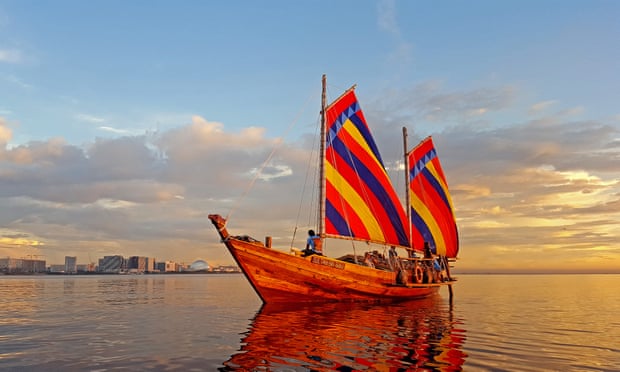You are here
Filipino seafarers to retrace sultan’s 600-mile journey across South China Sea in boats constructed using techniques from AD320
Filipino adventurers use ancient technology to recreate historic voyage
Oliver Holmes January 3, 2018 https://www.theguardian.com/world/2018/jan/03/filipino-seafarers-recreat...
A balangay boat: Adventurers plan to sail from the Philippines to China in boats constructed with techniques that date back to AD320. Photograph: Fung Yu/Balangay Voyage
Seafarers to retrace sultan’s 600-mile journey across South China Sea in boats constructed using techniques from AD320
Fierce monsoons and razor-edged reefs have proved deadly for Filipino seafarers for centuries, but there are more modern dangers lurking in the ocean for a crew of adventurers planning to sail the 600 miles to China in boats constructed with techniques that date to AD320.
“My greatest fear is to sail at night, because you can be run over by big ships,” said Arturo Valdez, 69, who is leading the mission. Without advanced navigation equipment, the only way his team will spot oil tankers is with their eyes. “We cannot even be seen on their radar because we are made of wood.”
Fierce monsoons and razor-edged reefs have proved deadly for Filipino seafarers for centuries, but there are more modern dangers lurking in the ocean for a crew of adventurers planning to sail the 600 miles to China in boats constructed with techniques that date to AD320.
“My greatest fear is to sail at night, because you can be run over by big ships,” said Arturo Valdez, 69, who is leading the mission. Without advanced navigation equipment, the only way his team will spot oil tankers is with their eyes. “We cannot even be seen on their radar because we are made of wood.”
The route to China
Filipino adventurers will set sail from the Philippines to China in spring 2018 in wooden replicas of an ancient balangay boat
Valdez and his team have tested the balangays. In 2009, they made a 17-month journey across south-east Asia, sailing from island to island and dropping anchor at night.
“If there was no wind we had to paddle our way. There was no communication, we had mobile phones, and we did not stay too far from the coastline,” he said. “We asked fishermen which is the best way to go. It was just to prove that in my DNA I am a seafarer.”
At one point, a monsoon storm blew them off course and they were afraid of being taken hostage in the southern Philippines, where kidnapping remains a lucrative business. “It was a matter of instinct – there were some close calls,” he said with a chuckle.
Valdez has rarely been lost on previous trips, but the forthcoming South China Sea leg will be more difficult because the crew will have to cross expanses of ocean.
It will be his third attempt to reach China. He tried to get there in a balangay from Vietnam in 2010, but the wind changed course, and a second trip was cancelled this summer after dangerous gales in the northern Philippines.
Advertisement
To Valdez’s dismay, rules in Chinese ports mean that for this trip they will have to carry some modern equipment. One of the three boats is required to have a motor, lights, and radio.
“I think this trip will be the last of its kind because you are not allowed to go to Hong Kong or Singapore unless you have the modern amenities that can communicate with port authorities,” he said.
The crew was fortunate that politics had not got in the way of their plans, he added. The Philippines and China are embroiled in a territorial dispute over parts of the South China Sea, which is rich in fisheries and crossed by important global shipping lanes.
To assert its power, Beijing has built military bases fitted with missile launchers on islands also claimed by Manila.
Those installations are not on Valdez’s route. “We don’t get involved in politics,” he said. “It is a cultural voyage … These waters in south-east Asia unified all the peoples. And I think, in a way, that’s the message of this entire voyage.”

